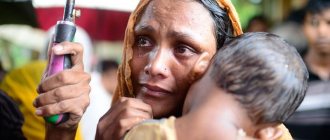Introduction
Violent crime is one of the components of the general structure of crime, which includes acts related to physical and mental violence against a person or the threat of its use. Violent crime can be understood in a broad sense - it includes all acts in which violence is a method of assault, and in a narrow sense - only those acts in which violence is one of the elements of criminal motivation [1].
Crime prevention is a function that, in accordance with current legislation, must be implemented by a wide range of subjects, which should most effectively reduce criminogenic tension in society, caused by many negative factors of a social, economic and political nature. It is obvious that preventive activities will have any tangible results only if they are aimed directly at those criminogenic factors that, by their existence, contribute to the reproduction and growth of criminal attacks in society. The increased social danger of selfish-violent crimes is determined by the fact that they simultaneously cause harm (or threaten harm) to the life or health of the person and property.
A particular danger in this regard is the recurrence of selfish and violent attacks on property.
In this regard, the study of criminological problems of preventing not only violent crimes against property, but also their relapse is relevant.
Criminal violence concept
In the “Explanatory Dictionary of the Russian Language” by D. N. Ushakov, violence is defined as:
1) applying physical force to someone;
2) the use of force, coercive influence on someone, something;
3) oppression, abuse of power, unlawful use of force[2].
Not all violence is the subject of consideration by criminologists, but only that which is associated with a violation of criminal law (criminal violence). There are two types of such violence[3]:
- Physical violence is the infliction of somatic, bodily harm on a person, up to and including taking his life.
- Mental violence - infliction of mental, moral harm: threats, insults, slander, blackmail, all types of coercion and restrictions on human freedom; also some types of deception, psychoprogramming and economic methods.
Not only violence itself, but also calls for it can be punishable. In addition, violence can act not only as a method of committing a crime, but also as a force that ensures the creation and sustainability of organized criminal groups[4].
Violent crime: concept, causes and conditions
This article discusses the concept and types of domestic violence. International and domestic legislation regulating violent crime is examined. A proposal is being made on the need to adopt a special law on the prevention and prevention of violent crimes in the family and domestic sphere.
Key words: violence, violent crime, family violence, physical violence, mental violence, prevention.
Violent crimes are one of the most dangerous latent groups of crimes, the fight against which is considered the main activity of Russian law enforcement agencies. Among violent crimes, violent crimes in the family occupy a special place.
The study of violence today attracts the closest attention of researchers in various fields of science.
Thus, in S.I. Ozhegov’s explanatory dictionary, violence is understood as: firstly, the use of physical force against someone, an act of violence; secondly, this is a forced influence on someone, a violation of personal integrity; thirdly, oppression, lawlessness [1, p. 436].
In sociology, violence is understood as the use by an individual or a social group of various forms of coercion against other individuals or social groups in order to acquire or maintain economic or political dominance.
In criminal law, violence is understood as the unlawful use of force, forced, i.e., against the will of another person, influence on him. The science of criminal law distinguishes two types of violence: physical violence is any socially dangerous and illegal direct impact on the life and health of a person, his rights and freedoms; mental violence is the threat of physical violence [2, p. 23].
Domestic violence has existed since time immemorial, but only in the last century did this problem begin to be perceived as a social problem that needs to be combated.
In modern conditions, family violence is expressed in different ways, so it seems appropriate to divide them into physical violence and mental violence. Let us give examples of domestic violence that we encounter in everyday life. Thus, the husband of citizen Ch., citizen O., systematically drinks with his neighbors. Returning home, each time he makes scenes of jealousy for his wife and beats her. The next day, regaining consciousness, he asks for forgiveness and makes a promise that this will not happen again. However, similar situations are repeated every time. The reasons for this behavior of citizen O. are the systematic use of alcoholic beverages and drugs.
In addition, there is also sexual violence in the family. Sexual violence is characterized by the fact that during rape or other acts of a sexual nature, attacks are made not only on the life, health, and bodily integrity of victims of domestic violence, but also on their honor and dignity, i.e., at the same time, sexual violence combines features of physical, and mental.
Physical violence should include crimes provided for in Articles 111–118 (and others) of the Criminal Code of the Russian Federation (CC RF). Psychological violence is provided for in Articles 110, 110.1 and 119 of the Criminal Code of the Russian Federation, for sexual violence the following articles 131–135 of the Criminal Code of the Russian Federation are provided. Most often, family violence occurs in unfavorable families, where parents systematically abuse alcohol and (or) drugs. However, domestic violence can also be observed in favorable families. Here violence can be expressed in the relationship between a despot husband and a victim wife.
The state’s reaction to violence, both outside the home and within the family, is significant, and a state that allows violence, which is perceived as commonplace, thereby destroys both society and the family. In the Russian Federation, violence in any form is punishable by law. The Constitution of the Russian Federation, in part 2 of Article 21, states: “No one should be subjected to torture, violence, or other cruel or degrading treatment or punishment. No one can be subjected to medical, scientific or other experiments without voluntary consent” [3].
Issues of domestic violence are regulated not only by the laws of the Russian Federation, but also by international law. Thus, the Declaration of the Rights of the Child of November 20, 1959 states that the child should be provided with special protection by law and other means and provided with opportunities and favorable conditions that would enable him to develop physically, mentally, morally, spiritually and socially in a healthy and healthy manner. in a normal way and in conditions of freedom and dignity. And also that the child must be protected from all forms of neglect, cruelty and exploitation [4]. The International Covenant on Civil and Political Rights of 16 December 1966 establishes that everyone, without any discrimination on account of race, colour, sex, language, religion, national or social origin, property or birth, has the right to such measures of protection aspects of the family, society, state [5].
An important issue is the prevention of domestic violence. One of the significant institutions for the special prevention of violent crime in the family is the Commissioner for Human Rights under the President of the Russian Federation and the Commissioner for Children's Rights under the President of the Russian Federation. A significant role in the prevention of violent crime in the family in Russia is assigned to the Prosecutor's Office of the Russian Federation, law enforcement agencies, guardianship and trusteeship authorities, social shelters, orphanages, rehabilitation centers, etc.
However, in Russia there is no special federal law regulating activities for the prevention and prevention of violent crimes in the family, which would define the basis of legal regulation in the field of preventing violent crimes in the family, establish preventive measures aimed at eliminating the danger of committing violent crimes in the family, and preventing recurrence committing violent crimes in the family. All preventive measures are enshrined in industry legislation.
Thus, the study allows us to formulate the following conclusions. Firstly, violent crime in the family should be understood as a socially dangerous, culpably committed act as a result of family and domestic conflicts, forming the elements of crimes of the Special Part of the Criminal Code of the Russian Federation, committed through the use of physical and mental violence. Secondly, we believe to distinguish between two main types of violence in the family: physical and mental, while sexual violence is a generic concept and includes both mental and physical violence. Thirdly, it seems possible and necessary to adopt a special federal law regulating activities to prevent violent crimes in the family and domestic sphere.
Literature:
- Ozhegov S. I. Explanatory dictionary of the Russian language [electronic resource] / S. I. Ozhegov // Access mode: https://gufo.me/dict/ozhegov (access date: 05.14.2018).
- Popov, A. N. Crime committed in a state of passion (Articles 107, 113 of the Criminal Code of the Russian Federation) / A. N. Popov. — 2nd ed., rev. and additional - St. Petersburg: St. Petersburg Law Institute of the General Prosecutor's Office of the Russian Federation, 2004. - 132 p.
- Constitution of the Russian Federation (adopted by popular vote on December 12, 1993) // Collection of legislation of the Russian Federation. - 2014. - No. 31. - Art. 4398.
- Declaration of the Rights of the Child (Adopted on November 20, 1959 by Resolution 1386 (XIV) at the 841st plenary meeting of the UN General Assembly) [electronic resource] // SPS “ConsultantPlus” (date of access: 05/14/2018).
- International Covenant on Civil and Political Rights (Adopted on December 16, 1966 by Resolution 2200 (XXI) at the 1496th plenary meeting of the UN General Assembly) [electronic resource] // ATP “ConsultantPlus” (date of access: 05.14.2018).
Typology of violent crimes
Yu. M. Antonyan offers several bases for the classification of criminal violence. First, he proposes to divide acts of violence according to the spheres of social life in which they are generated and in which they exist. Based on this criterion, we can distinguish [5]:
- Domestic violence, including those related to family relationships and joint work activities.
- Violence in public places: on the streets, in parks, courtyards.
- Violence in closed and semi-closed communities: in the army, prisons; This group includes cases when acts of violence are committed by some representatives of the contingent of these communities against other representatives.
- Repressive violence by representatives of the state and its bodies, including those related to national and racial discrimination.
- Violence associated with violation of the law of armed conflicts (international humanitarian law): against civilians, prisoners of war.
- Violence during interethnic, religious and other similar conflicts.
- Violence associated with the struggle for power.
Secondly, he proposes to divide violence by level: violence is distinguished at the state and interstate level; at the level of individual large groups of society; at the level of small social groups and individuals. Based on this, depending on the subject and object of violence, one can distinguish its horizontal and vertical varieties: the first is carried out in the absence of actual or formal relations of power and subordination between the subject or object, the second - in their presence.
Violent crime and violent crime
Violence is the main or auxiliary method of committing many crimes. Different groups of crimes are used in different countries of the world[6]:
- In the United States, at the federal level, the following types of violent crimes are taken into account in the Statistical Yearbooks on Crime in the United States: premeditated murder, rape, robbery, aggravated assault.
- In Sweden, statistical collections (Swedish: rattsstatistik arsbok) do not identify a separate group of violent crimes, but in scientific studies they include all types of murders, including unintentional ones, and attacks (including for the purpose of taking property). Sexual crimes are not classified as violent.
- In France, Japan and Russia, there is no separate category of “violent crimes” in statistical collections, and in theory there are different groupings.
In view of this, when analyzing violent crime, they usually do not turn to all types of crimes associated with violence, but only to the most dangerous of them, which are also punishable by the legislation of most states of the world, which makes it possible to compare the criminal situation not only within the territory of one state, but also all over the world.
Some of the most dangerous and widespread violent crimes include murder, grievous bodily harm, rape and hooliganism.
Crime and violent crime
In countries around the world, violence is one of the main or additional methods of committing criminal acts, but the formation of their groups is statistically somewhat different:
- in the United States of America, Federal publications of statistics take into account the deprivation of human life, forced sexual relations, robbery, as well as the commission of an attack under conditions that aggravate the guilt;
- in the Federal Republic of Germany: premeditated murder, forced sexual relations, robbery, causing bodily harm and life-threatening injuries, poisoning, kidnapping, holding citizens hostage, illegal demands for money and material assets;
- UK statistics take into account the category of “violent offenses” as all those aimed at infringing on the personality of citizens, including illegal termination of pregnancy, bigamy, and other “sexual” crimes;
- Swedish analysts do not include violent offenses as a separate sector, but scientific research by specialists includes all types of crimes, which include attacks for the purpose of taking property;
- statistical collections of France, Japan and our country do not include such crimes in a special group, and in theoretical studies there are some disagreements regarding individual definitions.
In this regard, when comparing the level of crimes of this nature, only those that pose the most significant threat to people and society are taken into account and are punished in the vast majority of countries in the world.
Examples
Crimes of the highest degree of gravity include, first of all, murder, and only if it was committed intentionally and with premeditation .
In addition, this category also includes other socially dangerous acts, for example, assault on the sexual integrity of a minor, terrorist actions, as well as actions inciting interethnic hostility, in general, all those violations that entail causing irreparable harm to the health and life of one person or group of persons .
Brief characteristics of certain types of violent crimes
The share of traditional types of violent crime in its overall structure is quite small (according to various estimates, from 1 to 5%). However, it is the most serious violent crimes that attract public attention; it is on the basis of the number of murders, rapes, and cases of hooliganism that society evaluates the effectiveness of law enforcement agencies.[7]
Murders
Murder is one of the most ancient and dangerous types of illegal acts known to mankind. Murder is considered a crime in all legal systems, although, of course, there are still certain differences in the understanding of what should be considered murder and what not.
In addition to the prevalence of violence in society, homicide rates depend on many factors, in particular the availability and quality of medical care, which reduces violent deaths.[8]
Rape
The most common sexual crime involving violence is rape. Its danger lies in the fact that both physical and mental suffering is caused to the victim; rape is often associated with lasting serious consequences, including infection with sexually transmitted diseases, mental disorders and even suicide of the victim[13].
It should also be noted that there are differences in the definition of the concept of “rape” in different countries: depending on the jurisdiction, the concept of rape can be narrowed or expanded, including or excluding other acts of a sexual nature in addition to sexual intercourse, acts committed without the use of actual violence, but taking advantage of the helpless state of the victim etc.
Hooliganism
Hooliganism is understood as a gross violation of public order, expressing disrespect for society. Hooliganism, as a rule, contains elements of violence, if not physical, then mental: the goal of a hooligan is outrage, insult, and gross mockery of people; he strives in this way to show his superiority over others, to assert himself[9].
The problem of hooliganism is often perceived in society as not too serious; hooliganism is considered by citizens and law enforcement agencies to be insufficiently significant to apply strict legal measures, including criminal law. Meanwhile, hooliganism is no less dangerous than other violent crimes. S. S. Ovchinsky points out that the actual impunity of hooligans leads to an increase in their aggressiveness, an increase in the severity of the harm caused, and ultimately to the commission of serious violent crimes: murder, rape, and causing serious harm to health[10].
Concept and general characteristics of violent crimes
Violent crimes constitute a group of the most dangerous attacks against life, health, bodily and sexual integrity of the person.
“Violent crime is a set of crimes committed with the use of physical force or with the threat of use thereof, having the main immediate purpose of depriving a person of life or causing harm to his health, physical freedom, bodily (including sexual) integrity against his will, as well as a set persons who committed violent crimes over a certain period in a certain territory.
The main feature that unites individual illegal acts and violent crimes is physical or mental violence against a person or the threat of its use. Moreover, violence in the commission of these crimes is an element of motivation, and not just a means of achieving a criminal goal. On this basis, the number of such crimes does not include violent robbery, robbery, extortion and a number of other acts where so-called instrumental violence is manifested, used exclusively as a means of achieving a selfish or, say, political goal.
The range of violent crimes is very diverse (the Criminal Code of the Russian Federation includes 55 articles providing for liability for crimes related to violence). Typically, however, attention is focused on the most dangerous manifestations of violence—violent crimes against the individual. These include criminal acts whose object is specifically and only a person: murder, causing grievous bodily harm, beatings, torture, rape, etc. When we talk about crimes such as kidnapping, robbery, hostage-taking, etc., we mean that their commission is associated with violence, which, as a rule, is used only as a means to achieve some goal, mainly material (for example, taking possession of property).”
In terms of the degree of social danger and the severity of the consequences caused, violent crimes are in many ways superior to other criminal manifestations and cause enormous damage to society. Hundreds of thousands of people are directly affected by them every year. These crimes damage the most important values in a civilized society - life, health, human integrity, and therefore they are the most dangerous from the point of view of law and universal morality.
Among violent crimes, the most persistent and significant part consists of “deliberate murders, intentional infliction of grievous bodily harm, rape, threats of murder and grievous bodily harm, intentional infliction of moderate harm to health. The state and dynamics of the commission of predominantly these crimes characterize violent crime in general.
A feature of violent crimes is also their insignificant but ever-increasing latency, explained by the nature of the acts and their difficult-to-conceal consequences.
It should be noted that in the last decade, along with the quantitative increase in violent crimes, their qualitative characteristics have also changed.
First of all, the number of violent crimes committed with the use of bladed weapons and firearms has increased, which is mainly caused by three groups of circumstances: the greater availability of weapons and the expansion of trade in them; a significant increase in the share of organized crime; wars and military conflicts on the territory of Russia and the CIS countries.
A new, hitherto unobserved type of violent crime has emerged—terrorist crime. This is not only terrorism and terrorist acts itself, but also a much larger group of very dangerous violent attacks, the distinctive feature of which is intimidation: hostage-taking, unlawful imprisonment, influence on law enforcement officers, witnesses and victims, threats of murder, infliction of grievous bodily harm , destruction of property, etc.
Since the beginning of the 90s. The serial number of violent criminal attacks has increased: rape (approximately doubled), robbery, banditry and extortion (approximately tripled). This is primarily explained by the impunity of criminals and the poor efficiency of law enforcement agencies.
There is a clear tendency for criminal acts to become more severe when committing murders and rapes.
Violence, including murder, has become a common way to solve economic, political, personal and even interpersonal problems. Therefore, a new type of crime appeared and became widespread - contract killings or murders for hire, which were almost never seen before, but in a short time turned into a familiar tool for regulating economic relations and redistributing spheres of criminal influence.
It can be stated that criminal violence has widely penetrated into those areas of life in which it was previously practically not manifested in any way, for example, in the area of financial and entrepreneurial activity, industry and trade, etc. At the same time, despite some reduction, the group of crimes related to violence manifested in family and household relations remains quite significant.
Violent crimes committed on domestic grounds against women and children pose a particular danger.
A feature of modern violent crime is also the increasing importance of the selfish motivation of criminals. Even “everyday” violent crimes against individuals, which are usually situational in nature, have become more often committed for self-interest.
According to many criminological characteristics, hooliganism is adjacent to violent crimes. Its share in the total number of registered crimes is quite high. The conducted research shows that hooliganism has been characterized by stable forms of manifestation for many decades. As a rule, hooligan acts precede the commission of serious crimes against the person by the same person. The state, structure and dynamics of violent crime do not, however, allow us to unequivocally answer the question about the reasons for the escalation of criminal violence in the country. For a deeper understanding of the nature of these crimes and ways to prevent them, an analysis of the personal characteristics of a violent offender is important.”
Violent Offender Identity
Although the general personality characteristics of a criminal apply to violent criminals, their personality has its own characteristics [18]. Thus, crimes related to violence are less often committed by women: about 90% of violent criminals are men. Women usually resort to domestic violence, especially in connection with the immoral and illegal behavior of the victim - usually a spouse or cohabitant. The age of the violent offender is usually quite young - under 40 years old. At the same time, crimes related to the deprivation of a victim’s life and causing harm to health are more often committed by persons aged 25-29 years, and rape - by persons under 25 years of age.
The educational and social level of violent criminals is lower than that of other categories of criminals and the population as a whole. As a rule, these individuals have relatively low qualifications, work in low-paid jobs or do not work at all.
Among violent criminals there are many repeat offenders, including those who have previously committed less serious crimes against the individual and public order. In addition, often those who commit violent crimes have a large baggage of immoral acts and offenses behind them: systematic abuse of alcohol, hooliganism, etc.
Violent criminals are characterized by violations of social identification and adaptation, desocialization. They weakly perceive the norms of behavior imposed by society, instead assessing the situation based on personal ideas and desires. There is also a primitiveness of needs, egocentrism and an impulsive desire to realize desires and needs, not restrained by self-control mechanisms. Socialization disorders also manifest themselves in difficulties in establishing contact with other people, who, as a result, are perceived as alien and hostile, regardless of their intentions. Such individuals are characterized by psychological mechanisms of self-defense: they believe that the actions they are accused of committing were provoked by the victims, and that they themselves acted correctly and should not be held responsible for this. The severity of such deviations can vary, resulting in individuals with a stable aggressive-violent personality orientation, situational criminals who generally behave positively or neutrally and commit a crime under the influence of external circumstances, as well as an intermediate type standing on the verge of socially acceptable.
Among violent criminals there are many psychopaths (according to various estimates from 30 to 60%) and people with borderline mental disorders. Among the most criminogenic mental anomalies, alcoholism is first mentioned, and then various personality disorders: dissocial, impulsive, emotionally unstable, paranoid, hysterical, schizoid[11].
Psychiatrist O. G. Vilensky distinguishes among other disorders schizoid, for which he considers typical pathological homicidomania - the desire to kill, which “in these people does not arise from delusional ideas or hallucinations, but exists on its own, prompting them to look for more and more victims”[ 12]. He writes that quite often this disorder explains the commission of many brutal and motiveless murders, including serial and sexual ones.
Personality Traits of a Violent Offender
Committing serious violent crimes is typical for men. Their share averages 88–92%.
The age structure of violent criminals depends on the nature and content of the assault. Thus, at least 65% of murders and infliction of grievous bodily harm and hooliganism, up to 80% of rapes are committed by persons aged 21 to 40 years. Persons younger and older than the specified parameters do not yet lay claim to leadership.
The educational level of violent criminals is inferior to the level of education not only of the population as a whole, but also of the entire contingent of persons committing crimes. Recently, people who do not even have a primary school education have begun to appear among them. This is clearly a negative trend.
In terms of social status, more than 50% of violent criminals are workers, and low-skilled ones at that. Among them, the proportion of people who do not engage in socially useful activities if they have real opportunities to do so is constantly increasing. Currently, according to various sociological data, this share has already reached 15–18%.
80% of murders and serious bodily harm, 75% of rapes, 70% of hooliganism are committed while under the influence of alcohol or drugs. Crimes while intoxicated, as a rule, are committed by persons in their own, narrow circle in the process of drinking alcoholic beverages while clarifying the nature and content of the relationship between themselves. Persons in a state of drug intoxication or drug withdrawal pose a significant danger to society. In order to obtain funds for their “dose,” they attack not only their parents, other relatives or friends, but also people they do not know.
Recidivism rates for serious and particularly serious violent crimes exceed the recidivism rate characteristic of crime in general. Persons with previous convictions account for more than 30% of murders, grievous bodily harm and rape, and about 25% of hooliganism. Among them, every second repeat offender is repeatedly convicted. Sometimes the number of convictions for these individuals approaches ten.
As the number of convictions increases, the proportion of those guilty of committing similar crimes decreases. For example, about 20% of violent criminals with a criminal record have previously been prosecuted for property offenses. Among repeat offenders who commit rape or hooliganism, a significant proportion are occupied by persons convicted for the first time as minors and early youth. Sociological studies have revealed a pattern that with an increase in the number of convictions, criminals move on to commit more and more dangerous crimes, including those of a violent nature.
The group commits about 15% of murders, 10% of grievous bodily harm, 50% of rapes and more than 30% of hooliganism. Groups generally consist of two or three people. A large proportion of gang rapes and hooliganism are committed by young people (under 25 years of age).
Approximately 50% of violent criminals are not in a marital relationship, and 10% of people have long-term marital relations. Almost 70% of them lived in a separate apartment or a separate house, and the rest lived in a dormitory, communal or so-called rented apartment.
The main motives for violent crimes are revenge, jealousy, hooligan and selfish motives, and sexual motives.
The criminological picture of violent crime is complemented by its victimological characteristics. In 13% of such crimes, harm is caused in connection with the criminal actions of the victim (violent attacks, hooliganism, theft, fraud), in 21% - in violation of other legal norms (civil, administrative), in 25% - in violation of moral standards. In rape cases, more than 50% of women provoke violence by immoral, reckless or sexually provoking behavior.
Research shows that more than 70% of victims of murder and grievous bodily harm, 20% of victims of rape, about 50% of victims of hooliganism were family members, relatives or boyfriends (girlfriends) of the criminals. Thus, serious violent crime as a whole has not lost its family-domestic character, and its development trends should be assessed sharply negatively.
Causes and conditions of violent crime
The characteristics of the personality of violent criminals described above, the relative smallness of the share of criminal violence and its relative constancy, the lack of a pronounced influence of social changes on the prevalence of violent crime leads some scientists to believe that the formation of the personality of a criminal, at least in relation to this group of crimes, may depend on biological and genetic predisposition. However, it is still generally accepted that the determination of violent crime, as well as crime in general, is predominantly social in nature: the causes and conditions of crime lie in the society in which it exists and to which it causes damage[13].
The cause of violence in general is primarily cited as unmet social needs. Ya. I. Gilinsky writes: “If an unsatisfied vital need (for food, procreation, protection from the cold, etc.) leads to a struggle for existence, then an unsatisfied social need leads to a “super-struggle for super-existence.” E. F. Pobegailo points out that in modern society the strongest social needs are associated with social stratification and social mobility, and it is the violation of social mobility or distortions in stratification that determine the bulk of cases of criminal violence. In addition, this author talks about such causes of criminal violence in society as a whole, such as migration, national and religious extremism, and armed conflicts[14].
In addition to the general determinants of crime (economic, social and moral), A. I. Dolgova names the following reasons that directly provoke the commission of violent crimes[15]:
- Disadvantages in the formation of personality, leading to the predominance in its character of such negative social qualities as cruelty, bitterness, envy, and a tendency to violence in everyday life.
- Demoralization associated with alcoholism and drug addiction, promiscuity, causing the emergence of specific small social groups in which violence becomes the only way to resolve interpersonal conflicts.
- Nationalistic, ethnocentric and subcultural traditions that lead to the division of society into “us” and “strangers”, the use of violence against which in the corresponding social environment is regarded neutrally or even positively.
- Remnants of patriarchal ideas about the need for complete subordination of a wife to her husband, and children to her parents, including the need to use violence as a method of “education” and maintaining authority.
- Ideology and standards of behavior of criminal and criminalized structures, including the mandatory use of violence in certain situations.
- The idea that violence is more effective as a means of achieving socio-political goals than legal methods.
- An opinion about the inaccessibility or ineffectiveness of official forms of response to violations of the rights and legitimate interests of citizens, leading to the use of lynching.
Among the social conditions that facilitate and promote the action of these causes, A. I. Dolgova names:
- Ineffective work of many government agencies, including law enforcement, which do not provide citizens with accessible, quick and effective ways to protect their rights and legitimate interests.
- The weakness of public institutions designed to smooth out everyday conflicts and provide assistance to their victims, which leads to the escalation of many such conflicts into crimes.
- Propaganda of violence by the media, relishing in them the details of violent acts, creating the impression of the prevalence and invincibility of criminal violence, making it attractive to subjects wishing to assert themselves.
- Underdevelopment of the system of social prevention, assistance and rehabilitation of persons with mental abnormalities, alcoholics, drug addicts.
The victim behavior of victims also plays an important role in the causal complex of many violent crimes. It is indicated that more than half of the serious violent crimes were committed in a conflict situation, accompanied by a “showdown” of several subjects, and that “only the case determined which of them was the victim and which was the accused”[16].
This is especially typical for rapes, where a significant part of the victims (according to research by G. B. Deryagin - 40%) themselves provoke the offender into sexual contact (usually by frivolous behavior in a situation involving joint consumption of alcohol with the rapist)[17].
Causes and conditions of crime
Criminologists define signs of violent crime:
- loss of faith in one’s abilities against the backdrop of difficult financial and living conditions that create the preconditions for aggressive behavior;
- the idea that violent behavior and aggression are acceptable in conflict situations;
- curbing the influence of criminal groups and their individual members;
- the reason for the crime was illegal, irresponsible or light behavior;
- excessive gullibility towards strangers on the part of the victims;
- antisocial attitude within the family, in places of work, with friends and acquaintances;
- dissemination of opinion about the positive side of sexual freedom, permissiveness, the influence of eroticizing microenvironments.
The causes and conditions of violent offenses are determined by the prerequisites for their commission, modern social realities of life and insufficient measures to suppress and prevent offenses.
The causes of violent crime are closely related to the development of the child’s personality and his entry into adulthood, including:
- resolution of conflicting family problems through violence;
- depressing environment in the place of residence, educational institutions;
- cruel attitude of loved ones towards others and animals;
- observation of clarification of relations with the use of force in places of large population;
- presence during acts of drunkenness, drug use, as well as their involvement.
Weaknesses in the work of law enforcement agencies
- insufficient preventive work to identify problems in the family and everyday life of citizens, delayed response;
- ignoring statements of threats of violence;
- prevention of criminal relapses;
- incomplete disclosure of crimes violating sexual integrity and against the person;
- insufficient efforts to identify and suppress prostitution; pornographic products should be withdrawn from sale;
- insufficient control over the illegal movement of weapons, poor quality checks of places where they are stored by owners who have a permit for them.
Among other things, the timely identification of persons with mental disorders and a tendency to aggression and violence plays an important role.
Violent Crime Prevention
There are two directions in the fight against violent crime and its prevention. The first is associated with the improvement of society as a whole, the reduction of general social preconditions for violent crime (general prevention), the second is associated with a targeted impact on the components of its causal complex (special prevention).[18]
Among the measures of general prevention of violent crime, A. I. Dolgova includes:
- Creating conditions for a civilized, legal resolution of conflicts between citizens, reducing their number and harmful consequences.
- Raising the cultural and educational level of citizens, ensuring healthy conditions for the formation of personality.
- Social control, which allows for a quick response to minor offenses and social conflicts, smoothing out their consequences and stimulating law-abiding behavior.
- Formation in the public consciousness of a negative attitude towards violence as a way of resolving conflicts, increasing the prestige of legitimate methods of protecting one’s rights.
Among the targets of special measures, she names, first of all, the criminal and criminogenic environment in which there are young people (under 29 years old), people without a permanent source of income and people who have previously committed crimes. A. I. Dolgova names the following special warning measures:
- Influence on persons who abuse alcohol and other psychoactive substances in order to resocialize them and encourage them to quit using these substances.
- Resocialization of persons released from prison: their employment, provision of housing, etc.
- Correction of behavior of persons with mental abnormalities, especially at an early stage (in children's institutions).
- Creation of psychological consultation centers aimed at rehabilitating victims of domestic violence and preventing new attacks on their interests.
- Victimological prevention, designed, if possible, to remove people from “risk groups” prone to committing violent crimes, to teach them the skills to avoid dangerous crime situations.
Violent crime prevention can also be achieved indirectly, by influencing other types of crime. For example, the fight against organized crime entails a reduction in overall violent crime, since it is violence that underlies the activities of organized criminal groups.
An important place in the system of preventing violent crimes is occupied by criminal law norms with the so-called double prevention, which establish responsibility for acts that precede the commission of serious violent crimes in the “criminal career” of the majority of dangerous criminals: hooliganism, threats to kill, illegal trafficking in weapons, etc. .[19]
The actual irresponsibility of persons committing such acts creates in them a sense of impunity and leads to an escalation of criminal behavior.







